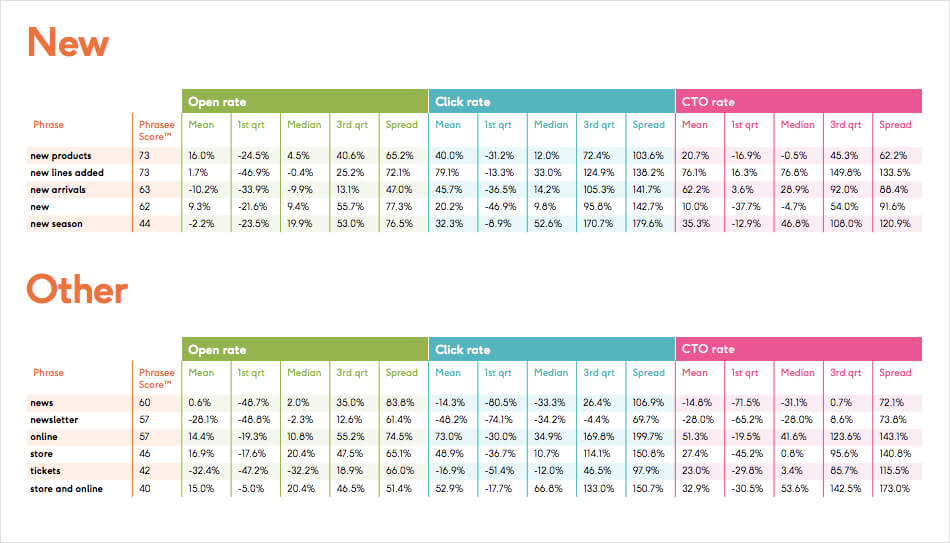
Crafting an email subject line that sells
By Sophia Skinbjerg | sophia.skinbjerg@ungapped.com
It’s the final week of 2015 – boy did that go fast! In terms of marketing campaigns, this week means it’s time for two things;
- It’s time to start planning 2016
- It’s time to reflect on 2015
Now for me, that not only means taking a look at our marketing performance as a whole but also taking a look at some of my favorite content from the past 12 months. One article I came across was a study shared by MarketingProfs earlier in the year about subject lines that sell.
Given that this time of year is when we get asked (often) by marketers how they can craft an email subject line that sells, I thought I’d take another look at the study and share some insights.
Lowdown on the study
The data we’re looking at here originally comes from a study taken out by Phrasee. They analyzed the performance of more than 700 million emails sent by retail and e-commerce brands (mostly based in the United States and the United Kingdom) against three KPIs:
- open rate
- click rates
- click-to-open rates
Noting the relationship between certain subject line elements and these KPIs, each individual element could be given a score from 1 to 100. This score, the “Phrasee Score”, reflected the likelihood of motivating consumers to take action. Essentially, the higher the score, the higher the probability.
What’s in a subject line anyway?
In order to know what makes a subject line work versus not work, Phrasee needed to know what’s included in a subject line. Phrasee broke down subject lines into these core groups;
- action or sales words
- action or sales phrases
- discounts
- urgency
- delivery
- punctuation
- questions
- superlatives
- product
- personalization
- greetings
- ‘newness’
- brand name
We’ve taken a look at just a selection of these groups and dot pointed a couple of key findings for each.
Note: You can click to enlarge the images. Just click back if you’re taken away from this page.
The results: action
“…all too often people forget the basics of consumer behavior.” – Phrasee
- Experiential verbs do better
- Ask your reader to do something: e.g. “buy” and “get your”
The results: discount
When it comes to percentage discounts, none of them scored so high that your mind will be blown. But that doesn’t mean the data isn’t interesting.
“For percentage discounts, it is hit or miss. You see the effects in the click through rate more than the open rate. Every single percentage discount offer varies wildly.
What this means is that percentage discounts, when used in an appropriate way, can deliver huge uplift to your results.” – Phrasee

The results: urgency
- Highlighting the urgency of a sale can drive action… but it can also sound like a broken record.
- The key is to try out variants that intone urgency… without being boring.
The results: personalization & product
- Personalization works when it’s done well
- Using a person’s first name in a subject line can work wonders
- Even simpler personalisation works just as well. E.g. intoning personalisation without actual personalisation!
- Including a personalised product selection in a subject line can have a negative effect on results.
The results: ‘newness’
- The word “New” in a subject line can evoke excitement amongst customers
- But, context is important
Things to think about when writing your next subject line
While the study makes it very clear that the results are not to be used in their entirety or exclusivity, what they found is still interesting and helpful for your day-to-day email marketing efforts.
For example, try to use action words or phrases that give a hint to something new, such as “introducing,” as they tend to perform well, as do words such as ‘celebrate”. Coupling this with a sense of urgency could boost your click-through rates to over 70% as was the case in emails which used ‘sale starts’ in their subject lines.
Alternatively, you could also try using discounts in your email subject line if you’re promoting a sale or special. Email subject lines with a discount number of 70% performed the best which makes sense – people love a good deal. Just try to avoid using a lower discount number than 30% as this might return less than average results according to this data.
If you’re running a campaign to win-back the attention of previous customers, using words or phrases related to newness or product in your subject line could very well be a way to increase performance in these three KPIs and sales.
Start crafting an email subject line that sells
Just log in here. Haven’t got an account yet? Create one for free here.



